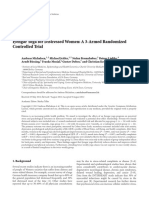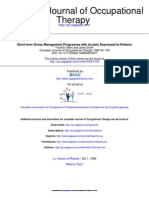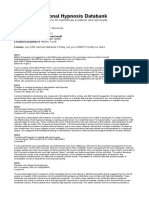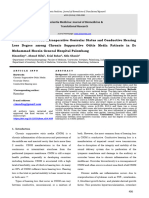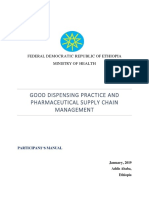0 ratings0% found this document useful (0 votes)
37 viewsRelaxation Techniques For People With Epilepsy:: Some Benefits and Cautions
Relaxation Techniques For People With Epilepsy:: Some Benefits and Cautions
Uploaded by
zingioStress is the most frequent trigger of seizures, and is linked with sleep deprivation and fatigue. Major life events which increased seizures included death, abuse, financial crisis, divorce, job loss, marriage and pregnancy / birth. A variety of relaxation techniques exist which aim to relieve stress and tension, reduce blood pressure, and improve feelings of control over our lives.
Copyright:
© All Rights Reserved
Available Formats
Download as PDF, TXT or read online from Scribd
Relaxation Techniques For People With Epilepsy:: Some Benefits and Cautions
Relaxation Techniques For People With Epilepsy:: Some Benefits and Cautions
Uploaded by
zingio0 ratings0% found this document useful (0 votes)
37 views3 pagesStress is the most frequent trigger of seizures, and is linked with sleep deprivation and fatigue. Major life events which increased seizures included death, abuse, financial crisis, divorce, job loss, marriage and pregnancy / birth. A variety of relaxation techniques exist which aim to relieve stress and tension, reduce blood pressure, and improve feelings of control over our lives.
Original Title
epilepsi2
Copyright
© © All Rights Reserved
Available Formats
PDF, TXT or read online from Scribd
Share this document
Did you find this document useful?
Is this content inappropriate?
Stress is the most frequent trigger of seizures, and is linked with sleep deprivation and fatigue. Major life events which increased seizures included death, abuse, financial crisis, divorce, job loss, marriage and pregnancy / birth. A variety of relaxation techniques exist which aim to relieve stress and tension, reduce blood pressure, and improve feelings of control over our lives.
Copyright:
© All Rights Reserved
Available Formats
Download as PDF, TXT or read online from Scribd
Download as pdf or txt
0 ratings0% found this document useful (0 votes)
37 views3 pagesRelaxation Techniques For People With Epilepsy:: Some Benefits and Cautions
Relaxation Techniques For People With Epilepsy:: Some Benefits and Cautions
Uploaded by
zingioStress is the most frequent trigger of seizures, and is linked with sleep deprivation and fatigue. Major life events which increased seizures included death, abuse, financial crisis, divorce, job loss, marriage and pregnancy / birth. A variety of relaxation techniques exist which aim to relieve stress and tension, reduce blood pressure, and improve feelings of control over our lives.
Copyright:
© All Rights Reserved
Available Formats
Download as PDF, TXT or read online from Scribd
Download as pdf or txt
You are on page 1of 3
19 THE EPILEPSY REPORT JUNE 2007
Stress & Seizures
It is widely accepted that stress can trigger seizures for
many people with epilepsy. In one survey of 177 patients, 58
per cent identifed that seizures occurred more frequently
when they were stressed, with seizures occurring sometimes
days or weeks later (Mattson, 1991). Similar studies also
indicate that stress is the most frequent trigger of seizures, and
is linked with sleep deprivation and fatigue (Frucht, Quigg,
Schwaner & Fountain, 2000).
In a more recent survey of 89 patients, 64 per cent of people
with epilepsy reported that they believed stress increased the
frequency of their seizures (Haut, Vouyiouklis & Shinnar,
2003). 32 per cent had tried stress reduction techniques, and
of those who hadnt, 53 per cent were willing to try. However,
it is not just stress, but also life events that are reported to
infuence seizure frequency. Major life events identifed by
people interviewed in the study include death, abuse, fnancial
crisis, divorce, job loss, marriage and pregnancy/birth. Minor
life events which increased seizures included family tension,
arguments, time pressure, debt and traffc/car related events.
It would seem to make sense that when managing an
important issue like stress, using relaxation techniques which
some benefts
Feeling stressed, overwhelmed, and under pressure is a common experience for us
all. The challenges and demands of modern day-to-day life can impact our physical
and mental health, particularly if you also have epilepsy. So what can we do about it?
There has been a lot of contentious discussion about the benefts and limitations of
various relaxation techniques for people with epilepsy. Do they work? What are the
risks? This article will briefy review important points you need to know before you buy
that yoga mat.
Michelle Bellon, PhD
Department of Disability Studies
Flinders University
Relaxation
techniques
for people
with epilepsy:
are accessible, affordable, and easy to do appear a logical self-
management approach. So, why the discussion?
Take a Deep Breath
A variety of relaxation techniques exist which aim to relieve
stress and tension, reduce blood pressure, and improve feelings
of control over our lives. Workshops and classes in progressive
muscular relaxation, meditation, yoga, tai chi, massage, and
acupuncture can be found in increasing numbers. Many of
these techniques have reported improved sleep, decreased
aggravation and tension during the day, increased overall
health, and reduced fear of seizures, indicating a greater
sense of well being (Rosseau, Hermann & Whitmann, 1985).
In addition, the general observation that techniques like
meditation are side effect-free (in contrast to drugs) is of
great appeal*. Table 1 provides an overview of studies which
examine relaxation in epilepsy management.
* Important note: relaxation techniques are recommended
as a complementary approach, and not a replacement to
medication.
and cautions
20 THE EPILEPSY REPORT JUNE 2007
Table 1. Studies featuring relaxation in epilepsy management
Reference Study
Dodrill, Batzel, Queissen No signifcant results of relaxation were reported on the Washington Psychosocial Seizure
& Temkin (1980) Inventory, yet participants reported progressive relaxation had improved their lives (e.g., by
facilitating openness with parents which may have refected the nonspecifc effects of social
support in relaxation therapy).
Snyder (1983) Three out of four adults trained in relaxation and who practiced for at least 15 days per month
experienced an average reduction in seizure frequency.
Dahl, Melin & Lund (1987) Contingent relaxation involves learning to apply progressive muscular relaxation (which
people learn to associate with bodily sensations and environmental situations that are
incompatible with seizure occurrence) to situations and feelings associated with a high risk of
seizure activity. Results report a 66 per cent decrease in seizure frequency. This study also
found that where pre-seizure signals are associated with fear or stress, relaxation reduced
negative emotional reactions and helped people to cope. Reports included gaining greater
control over seizures and reducing their danger, while improving confdence and enabling
greater independence.
Whitman, Dell, Legion, 12 people trained with progressive muscular relaxation were followed up at 8, 16 and 24 weeks
Eibhlyn & Statsinger (1990) post-treatment. Although a decrease in seizure frequency from baseline to frst follow-up was
only marginally signifcant, the reduction in frequency continued, with a signifcant 54 per cent
reduction in median seizure frequency after 6 months. No control group was included.
Fried (1993) Diaphragmatic breathing was used to counteract hyperventilation, which may itself lower
seizure thresh-holds and contribute to the occurrence of seizures. Carbon dioxide loss
demonstrated to have an almost linear relationship to decreases in EEG frequency and seizure
onset.
Miller (1994) People who practice relaxation regularly were reported to be more likely to take their
medication conscienciously.
Deepak, Manchanda & Meditation for 20 minutes daily resulted in signifcant seizure reduction as opposed to the
Maheshwari (1994) control group. Relaxation training was reported to signifcantly reduce seizure frequency.
Panjwani et al (1996) Randomised control trial of 32 people with uncontrolled epilepsy, medication continued. 10
people were treated with sahaja yoga, 10 people were treated with exercises mimicking sahaja
yoga (sham treatment), and 12 people were controls without any treatment. Yoga was practiced
twice daily for 20-30mins over 6-month period. 9 of 10 people in the yoga group had 50%
reduction in seizure frequency, compared to 1 in the sham treatment group, and none in the
control group.
Arias, Steinberg, Banga & Systematic review of the effcacy of meditation techniques for treating serious medical
Trestman (2006) illness. 82 studies were reviewed with a total of 958 subjects. No serious adverse events of
meditation were reported in any of the included or excluded clinical trials. The strongest
evidence for effcacy was found for epilepsy, premenstrual syndrome and menopausal
symptoms.
Apart from epilepsy management, relaxation training
has also been demonstrated as effective when held at the
beginning of training sessions. Deep breathing exercises have
been shown to reduce anxiety and inhibit the stress response,
allowing the person with epilepsy to be more open to learning
as well as assisting with indirect diffculties of depression
and social isolation (Gupta & Naorem, 2003). Such benefts
seem to provide strong support for the inclusion of relaxation
programs in management interventions.
Still Looking for Evidence
There is a large pool of anecdotal evidence which indicates
the effectiveness of different relaxation approaches. However,
robust scientifc research is lacking to support the effcacy and
safety of many relaxation interventions in epilepsy.
A Cochrane Review on the effcacy of yoga as a treatment
for epilepsy found only one quasirandomized, unblinded,
controlled trial, and could report no reliable conclusions
(Ramaratnam & Sridharan, 2002). A second Cochrane Review
on relaxation therapy and seizure control indicates only
possible benefcial effects on seizure frequency (Ramaratnam,
Baker & Goldstein, 2005).
Acupuncture in epilepsy has similarly been reviewed (Cheuk
& Wong, 2006). Three studies meeting selection criteria
explored the effects of acupuncture (Kloster, 1999; Ma 2001;
Xiong, 2003), with no evidence to support it as an effective
treatment for epilepsy. It is important to note that despite some
positive reports in individual studies, no reliable evidence is
provided and defnite conclusions cannot be made. Further
research containing rigorous study designs are needed.
21 THE EPILEPSY REPORT JUNE 2007
Arias, A.J., Steinberg, K., Banga, A., & Testman, R.L. (2005). Systematic
review of the effcacy of meditation techniques as treatments for medical
illness. Journal of Alternative Complementary Medicine, 12(8), 817-832.
Cheuk DKL, Wong V. (2006). Acupuncture for epilepsy. Cochrane
Database of Systematic Reviews, Issue 2. Art. No.: CD005062.
DOI:10.1002/14651858. CD005062.pub2.
Dahl, J., Melin, L., & Lund, L. (1987). Effects of a contingent relaxation
treatment program on adults with refractory epileptic seizures. Epilepsia, 28,
125-132.
Deepak, K., Manchanda, S., & Maheshwari, M. (1994). Meditation
improves clinicoelectroencephalographic measures in drug-resistant
epileptics. Biofeedback Self Regulation, 19(1), 25-40.
Dodrill, C., Batzel, L., Queisser, H., & Temkin, N. (1980). An objective
method for the assessment of psychological and social problems among
epileptics. Epilepsia, 21, 123-135.
Freid, R. (1993). Breathing training for the self-regulation of alveolar CO2
in the behavioural control of idiopathic epileptic seizures. In D. Mostofsky,
& Y. Loyning. (Eds.). The neurobehavioral treatment of epilepsy. New Jersey:
Lawrence Erlbaum Associates.
Frucht, M.M., Quigg, M., Schwaner, C., Fountain, N.B. (2000).
Distribution of seizure precipitants among epilepsy syndromes. Epilepsia, 41,
1534-1539.
Gupta, A., & Naorem, T. (2003). Cognitive retraining in epilepsy. Brain
Injury,17(2), 161-174.
Haut, S.R., Vouyiouklis, M., & Shinnar, S. (2003). Stress and epilepsy: a
patient perception survey. Epilepsy & Behavior, 4, 511-514.
Jaseja, H. (2005). Meditation may predispose to epilepsy: an insight
into the alteration in brain environment induced by meditation. Medical
Hypotheses, 64, 464-467.
Kumar, R.A., & Kurup, P.A. (2003). Changes in the isoprenoid pathway
with transcendental meditation and Reiki healing practices in seizure
disorder. Neurology India, 51, 211-214.
Lansky, E.P., & St Louis, E.K. (2006). Transcendental meditation: a
double-edged sword in epilepsy? Epilepsy & Behavior, 9, 394-400.
Mattson, R.H. (1991). Emotional effects on seizure occurrence. In Smith
D., Treiman D., Trimble M (eds.). Advances in neurology, Vol 51. New York:
Raven Press.
Miller, L. (1994). Psychotherapy of epilepsy: seizure control and
psychosocial adjustment. The Journal of Cognitive Rehabilitation, Jan/Feb,
14-30.
Panjwani, U., Selvamurthy, W., Singh, W., Gupta, H. L., Thakur, L., &
Rai, U. C. (1996). Effects of Sahaja Yoga practice on seizure control and EEG
changes in patients with epilepsy. Indian Journal of Medical Research, 103,
165-172.
Ramaratnam, S., Baker, G.A. & Goldstein, L.H. (2005). Psychological
treatments for epilepsy (review). Cochrane Database of Systematic Reviews,
Issue 4. Art. No.:CD002029. DOI: 10.1002/14651858.CD002029.pub2
Ramaratnam S, Sridharan K. (2002). Yoga for epilepsy. Cochrane Database
of Systematic Reviews, Issue 1. Art. No.: CD001524. DOI:10.1002/14651858.
CD001524.
Rousseau, A., Hermann, B., & Whitmann, S. (1985). Effects of progressive
relaxation on epilepsy: analysis of a series of cases. Psychological Reports,
57, 1203-1212.
Snyder, M. (1983). Effect of relaxation on psychosocial functioning in
persons with epilepsy. Journal of Neurosurgical Nursing, 15, 250-254.
Whitman, S., Dell, J., Legion, V., Eibhlyn, A., & Statsinger, J. (1990).
Progressive relaxation for seizure reduction. Journal of Epilepsy, 3, 17-22.
Risks for Epilepsy
Certain relaxation techniques (namely meditation) have been
reported to be potentially dangerous for people with epilepsy.
Lowered blood pressure and brain electrophysiological arousal
can be triggered which are associated with triggering seizures
in some people (Miller, 1994). Lets review the evidence.
Effects of Meditation on the Brain
Neuroimaging advances in EEG, fMRI, PET and SPECT
techniques have brought with them new insight to our
understanding of how various relaxation techniques alter
our brain function. Studies have revealed that individual
techniques such as meditation have complex infuences on the
brain, which change mental, neuron-hormonal and autonomic
functions (Jaseja, 2005; Lansky & St Louis, 2006). Jasejas
review identifed the following neuro-effects of meditation:
EEG changes in alpha and theta frequencies
increase in synchrony of EEG activity (hypersynchrony)
increase in inter-hemispheric coherence of EEG activity
increase in brain Serotonin (implicated in epilptogenesis)
increased production of brain Glutamate (an excitatory
neurotransmitter)
Jaseja cautions that each of these effects which occur during
meditation can increase a persons risk for epileptogenesis and/
or trigger a seizure in a person with epilepsy. It is important
to be aware that meditating when you have epilepsy can be a
potentially hazardous practice (Jaseja, 2005).
Lansky & St Louis (2006) provide an in depth review of
the effects of Transcendental Meditation (TM) on people with
epilepsy. Simply described, TM involves the repetition of a
mantra during multiple sessions over the day, and can also
include yogic postures (asanas), alternate nostril breathing
exercises (pranayama) and advanced techniques including
Flying (Sidhis) in which involuntary muscle contractions
are induced to allow the fyer a paroxysmal movement into
the air from a sitting position (p395). Their fndings indicate
that this form of mediation, like others which produce
powerful physiological effects, should be treated with respect
and caution by people with epilepsy. It was hypothesized
that theoretically, repetitive TM could trigger seizures in
susceptible people while in the meditative state, or meditation
could lead to kindling which could lead to the development
of epilepsy, and seizures between meditation sessions.
Alternatively, other studies suggest TM may also be a potential
antiepileptic therapy (Kumar & Kurup, 2003). There is no
persuasive scientifc evidence to indicate that TM is either
therapeutic, or possesses epileptogenic effects. The authors
highlight the need for well-designed and unbiased research on
the topic.
Final Comments
It is important to be aware of the potential risks, as well
as the benefts of various relaxation approaches for people
with epilepsy. There are many ways relaxation can be
helpful in managing stress and improving quality of life, and
these should not be overlooked. However, there is a lack of
research evidence to support the effcacy and safety of certain
relaxation approaches (namely meditation) in epilepsy. The
suggestion that these interventions be treated with respect and
caution should be heeded until further research is done.
References
You might also like
- Physical Activity in The Prevention and Treatment of Anxiety and DepressionDocument6 pagesPhysical Activity in The Prevention and Treatment of Anxiety and DepressionenilNo ratings yet
- Literature Review - Ali WeekleyDocument7 pagesLiterature Review - Ali Weekleyapi-559220255No ratings yet
- Iyengar Yoga For Distressed Women A 3 ArDocument10 pagesIyengar Yoga For Distressed Women A 3 Ardarshana shahNo ratings yet
- Journal of Affective Disorders: Research PaperDocument11 pagesJournal of Affective Disorders: Research PaperIvan Andres TorrisiNo ratings yet
- Physical Exercise Intervention in Depressive Disorders: Meta-Analysis and Systematic ReviewDocument14 pagesPhysical Exercise Intervention in Depressive Disorders: Meta-Analysis and Systematic ReviewNelsonRodríguezDeLeónNo ratings yet
- Exercise and The Prevention of DepressionDocument9 pagesExercise and The Prevention of DepressionEdlene HoffmannNo ratings yet
- Effects of Qi Therapy (External Qigong) On Premenstrual Syndrome: A Randomized Placebo-Controlled StudyDocument8 pagesEffects of Qi Therapy (External Qigong) On Premenstrual Syndrome: A Randomized Placebo-Controlled StudyShe YuNni WahyuniNo ratings yet
- Exercise and The Prevention of Depression: Results of The HUNT Cohort StudyDocument9 pagesExercise and The Prevention of Depression: Results of The HUNT Cohort StudyLydia AmaliaNo ratings yet
- NEJM PrescribingTaiChiForFibromyalgiaDocument2 pagesNEJM PrescribingTaiChiForFibromyalgiaAdriano Carneiro da RochaNo ratings yet
- Mindfulness For Stress Reduction MDocument16 pagesMindfulness For Stress Reduction Mapi-557851251No ratings yet
- Review InsomniaDocument17 pagesReview InsomniaIta Punya ShintaNo ratings yet
- JCP 13m08561Document7 pagesJCP 13m08561ankitabhitale2000No ratings yet
- Anxiety July 2011Document8 pagesAnxiety July 2011aswadiibrahimNo ratings yet
- Qigong For TN Research PaperDocument15 pagesQigong For TN Research Paperapi-399928223No ratings yet
- Research PaperDocument7 pagesResearch Paperapi-317123584No ratings yet
- Yoga On Our Minds: A Systematic Review of Yoga For Neuropsychiatric DisordersDocument16 pagesYoga On Our Minds: A Systematic Review of Yoga For Neuropsychiatric DisordersDaniela DiazNo ratings yet
- Jurnal Mengurangi Nyeri Meningkatkan Kualitas DepresiDocument6 pagesJurnal Mengurangi Nyeri Meningkatkan Kualitas DepresiPerdanaNo ratings yet
- Yoga in Health and DiseaseDocument3 pagesYoga in Health and DiseaseRagavendrasamyNo ratings yet
- Effect of Acupressure On Physiological and Psychological Maladies Among Peri and Post Menopausal WomenDocument6 pagesEffect of Acupressure On Physiological and Psychological Maladies Among Peri and Post Menopausal WomenInternational Journal of Innovative Science and Research TechnologyNo ratings yet
- M - B S H: Ind Ody and Piritual EalingDocument0 pagesM - B S H: Ind Ody and Piritual EalingPrateek RijhwaniNo ratings yet
- Torque Release TechniqueDocument3 pagesTorque Release TechniqueEd RibeiroNo ratings yet
- YogaDocument19 pagesYogaemanuelle rodriguesNo ratings yet
- Mind Set MattersDocument7 pagesMind Set MattersSrikar BonguNo ratings yet
- Is It All in Your Head?: Advances in Mind Body MedicineDocument44 pagesIs It All in Your Head?: Advances in Mind Body MedicineHien NguyenNo ratings yet
- The Use of Hypnosis in Boosting The Effect of Cognitive Behavioural Therapy in The Treatment of Chronic FatigueDocument6 pagesThe Use of Hypnosis in Boosting The Effect of Cognitive Behavioural Therapy in The Treatment of Chronic FatigueadamhomeNo ratings yet
- Chronotherapeutics Light and Wake Therapy in Affective DisordersDocument6 pagesChronotherapeutics Light and Wake Therapy in Affective DisordersAnonymous zxTFUoqzklNo ratings yet
- Yoga and AxietyDocument14 pagesYoga and AxietyLie LhianzaNo ratings yet
- Effectiveness of Therapeutic Massage For Generalized AnxietyDocument19 pagesEffectiveness of Therapeutic Massage For Generalized AnxietyMiki ShimizuNo ratings yet
- Meditation With Yoga, Group Therapy With Hypnosis, and Psychoeducation For Long-Term Depressed Mood: A Randomized Pilot TrialDocument16 pagesMeditation With Yoga, Group Therapy With Hypnosis, and Psychoeducation For Long-Term Depressed Mood: A Randomized Pilot TrialAnonymous 6h9W2AeSCNo ratings yet
- Canadian Journal of Occupational TherapyDocument9 pagesCanadian Journal of Occupational TherapyFrancesca Gozman100% (1)
- Research ArticleDocument9 pagesResearch Articlekamblineha0No ratings yet
- Kelley RA 97Document10 pagesKelley RA 97Mihaela GhermanNo ratings yet
- Effectiveness of Physical Therapy in Patients With Tension-Type Headache: Literature ReviewDocument8 pagesEffectiveness of Physical Therapy in Patients With Tension-Type Headache: Literature Reviewratnayanti udinNo ratings yet
- Exercise and DepressionDocument5 pagesExercise and DepressionDumitrescu TinaNo ratings yet
- Bernstein McNally 2018 Behaviour Research and TherapyDocument8 pagesBernstein McNally 2018 Behaviour Research and TherapyIordache LarisaNo ratings yet
- Eft Vets Study PDFDocument13 pagesEft Vets Study PDFKing GeorgeNo ratings yet
- PHDDocument309 pagesPHDAndré HipnotistaNo ratings yet
- Nielsen Mork MasteroppgaveDocument86 pagesNielsen Mork MasteroppgaveAbdullah aslamNo ratings yet
- Efektifitas Terapi Massage Dengan Terapi Mandi Air Hangat TerhadapDocument8 pagesEfektifitas Terapi Massage Dengan Terapi Mandi Air Hangat TerhadapAlfi Rohmatus SholihahNo ratings yet
- Daoist Studies 03Document32 pagesDaoist Studies 03Cassio SagaNo ratings yet
- The Exercise EffectDocument6 pagesThe Exercise EffectHemantNo ratings yet
- 2007 - Psychophysiological Effects of Breathing Instructions For Stress ManagementDocument10 pages2007 - Psychophysiological Effects of Breathing Instructions For Stress ManagementVeronica JanethNo ratings yet
- HHS Public Access: Exercise For Mood and Anxiety Disorders: The State-Of-The ScienceDocument4 pagesHHS Public Access: Exercise For Mood and Anxiety Disorders: The State-Of-The ScienceNICOLAS GOMEZNo ratings yet
- Evidence For The Effectiveness of Spiritual HealingDocument2 pagesEvidence For The Effectiveness of Spiritual HealingavncntnNo ratings yet
- The Effects of Qigong On Reducing Stress and Anxiety and Enhancing Body Mind Well BeingDocument10 pagesThe Effects of Qigong On Reducing Stress and Anxiety and Enhancing Body Mind Well BeingSamo JaNo ratings yet
- Appreciation of PhilosophyDocument6 pagesAppreciation of PhilosophyShan ElahiNo ratings yet
- Student PaperDocument12 pagesStudent PaperKathryn Caxandra Toledo Luna100% (1)
- Guided Imagery and Progressive Muscle Relaxation in Group PsychotherapyDocument12 pagesGuided Imagery and Progressive Muscle Relaxation in Group PsychotherapymidumeNo ratings yet
- Mindfulness and Chronic Pain 2Document28 pagesMindfulness and Chronic Pain 2Yow MamaNo ratings yet
- Cruwysetal JAD2014Document8 pagesCruwysetal JAD2014dori45No ratings yet
- The Feasibility of Tai Chi ExerciseDocument12 pagesThe Feasibility of Tai Chi Exerciselsj19950128No ratings yet
- Thesis 6Document5 pagesThesis 6karunamightymech306No ratings yet
- Accupressure, Pain 4Document5 pagesAccupressure, Pain 4Akmal ThariqNo ratings yet
- HealthDocument5 pagesHealthSherria NicoletteNo ratings yet
- Yoga As An Adjunctive Treatment For PTSDDocument7 pagesYoga As An Adjunctive Treatment For PTSDFirna NovitaNo ratings yet
- Lavretsky 2013 Int J Geriatr PsychiatryDocument9 pagesLavretsky 2013 Int J Geriatr PsychiatrytaxialuendaNo ratings yet
- Texto Exercício Aeróbico Saúde Mental Uma Revisão Sistemática e Meta-Análise.Document15 pagesTexto Exercício Aeróbico Saúde Mental Uma Revisão Sistemática e Meta-Análise.canaldasprofissoesNo ratings yet
- Freedom from Pain: Discover Your Body's Power to Overcome Physical PainFrom EverandFreedom from Pain: Discover Your Body's Power to Overcome Physical PainRating: 4 out of 5 stars4/5 (2)
- An Integrative Paradigm for Mental Health Care: Ideas and Methods Shaping the FutureFrom EverandAn Integrative Paradigm for Mental Health Care: Ideas and Methods Shaping the FutureNo ratings yet
- Bronchodilators and Other Drugs Used in AsthmaDocument61 pagesBronchodilators and Other Drugs Used in AsthmazingioNo ratings yet
- Brain Tumors Final 001Document50 pagesBrain Tumors Final 001zingioNo ratings yet
- Jurnal 2Document12 pagesJurnal 2zingioNo ratings yet
- Obstructed LaborDocument14 pagesObstructed LaborzingioNo ratings yet
- Obstructed LaborDocument14 pagesObstructed LaborzingioNo ratings yet
- 409-Article Text-1439-1-10-20211018Document12 pages409-Article Text-1439-1-10-20211018Anonymous a2nxIq5No ratings yet
- MIS602 Assessment2 Case StudyDocument2 pagesMIS602 Assessment2 Case StudyMadhawa UdawattaNo ratings yet
- Volume 15, Number 5 May 2011Document188 pagesVolume 15, Number 5 May 2011Nicolai BabaliciNo ratings yet
- Osce05ans 110918053819 Phpapp01Document20 pagesOsce05ans 110918053819 Phpapp01masood alamNo ratings yet
- Niosh PDD BofaDocument4 pagesNiosh PDD BofaSaiful SelamatNo ratings yet
- Croatian Society of Radiology (1928-2008)Document12 pagesCroatian Society of Radiology (1928-2008)Anonymous 9QxPDpNo ratings yet
- 10 Golden Rules For Administering Drug SafelyDocument5 pages10 Golden Rules For Administering Drug SafelyAngel EsplenadaNo ratings yet
- Punjab Public Service CommissionDocument2 pagesPunjab Public Service Commissionmaryam saghirNo ratings yet
- Khush EnterprisesDocument2 pagesKhush Enterprisescheema4133No ratings yet
- Andrea Nicole Valencia: Career ObjectivesDocument3 pagesAndrea Nicole Valencia: Career ObjectivesReginald TuazonNo ratings yet
- Dement, W. C., Vaughan, C. C. (1999) - The Promise of Sleep. New York City: Dell PublishingDocument7 pagesDement, W. C., Vaughan, C. C. (1999) - The Promise of Sleep. New York City: Dell PublishingIlyas RadhianNo ratings yet
- Principles of Surgical Management TreatmentDocument4 pagesPrinciples of Surgical Management Treatmenttamilvanan3No ratings yet
- Diah Mustika HW, SPS, Kic Intensive Care Unit of Emergency Department Naval Hospital DR Ramelan, SurabayaDocument33 pagesDiah Mustika HW, SPS, Kic Intensive Care Unit of Emergency Department Naval Hospital DR Ramelan, SurabayaNabilaNo ratings yet
- Serum Thyroid-Stimulating Hormone Is An Independent Risk Factor of Recurrent Guillain-Barré SyndromeDocument41 pagesSerum Thyroid-Stimulating Hormone Is An Independent Risk Factor of Recurrent Guillain-Barré SyndromeDr NIVEDITHA CNo ratings yet
- Drug Study OxytocinDocument3 pagesDrug Study OxytocinSheena Marie M. TarleNo ratings yet
- MethodsDocument12 pagesMethodsMohammad_Islam87No ratings yet
- Pediatric DentistryDocument15 pagesPediatric DentistryPeyman Dhg100% (2)
- RPIC - FO - 0023 - Ethics Application Procedure-4Document7 pagesRPIC - FO - 0023 - Ethics Application Procedure-4JHON LLOYD LALUCESNo ratings yet
- The CIP (Comprehensive Integrative Puzzle) Assessment MethodDocument6 pagesThe CIP (Comprehensive Integrative Puzzle) Assessment MethodFrederico PóvoaNo ratings yet
- Rovamycin 3868 DR 1256036243912Document6 pagesRovamycin 3868 DR 1256036243912Ahmed El AlfyNo ratings yet
- Medicine in The Middle AgesDocument11 pagesMedicine in The Middle AgesOksana KolomiichukNo ratings yet
- Zipfel ANTOPDocument14 pagesZipfel ANTOPlevickiene85No ratings yet
- Appendix CDocument16 pagesAppendix CJessy Arcaina BañagaNo ratings yet
- Good Dispensing Practice and Pharmaceutical Supply ChainDocument338 pagesGood Dispensing Practice and Pharmaceutical Supply ChainMoses TabiwanNo ratings yet
- Saint Francis of Assisi College: PSYC 411 Abnormal PsychologyDocument6 pagesSaint Francis of Assisi College: PSYC 411 Abnormal PsychologyEsraRamosNo ratings yet
- Best Practice & Research Clinical Anaesthesiology: François Lellouche, MD, PHD, Doctor, Laurent Brochard, MD, ProfessorDocument13 pagesBest Practice & Research Clinical Anaesthesiology: François Lellouche, MD, PHD, Doctor, Laurent Brochard, MD, Professorkittykm chuiNo ratings yet
- Inclined Bed Therapy - ElectroHerbalismDocument3 pagesInclined Bed Therapy - ElectroHerbalismambertje12No ratings yet
- How To Write A Clinical Review Article:: A Medical Writing SeminarDocument36 pagesHow To Write A Clinical Review Article:: A Medical Writing SeminarrejuvenNo ratings yet
- Chilaiditi Syndrom in Child Diagnostic Trap (Case Report)Document6 pagesChilaiditi Syndrom in Child Diagnostic Trap (Case Report)IJAR JOURNALNo ratings yet
- Vesiculobullous LesionsDocument130 pagesVesiculobullous LesionsRobins DhakalNo ratings yet


